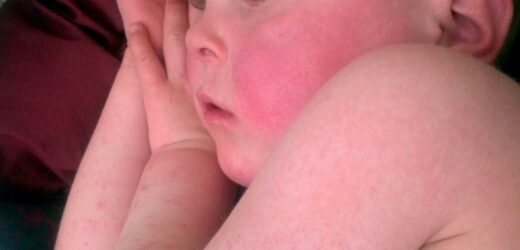Scarlet fever: Doctor details symptoms of bacterial infection
We use your sign-up to provide content in ways you’ve consented to and to improve our understanding of you. This may include adverts from us and 3rd parties based on our understanding. You can unsubscribe at any time. More info
Scarlet fever is an infectious disease caused by group A streptococcus bacteria that mostly affects children aged 5–15 and can be easily treated by antibiotics. The first signs of the conditions are often flu-like in nature, including a high temperature, sore throat and swollen neck glands. This is followed within 12–48 hours by a rash that starts on the chest and stomach area before spreading, leaving the skin feeling rough like sandpaper.
The rash results from a substance produced by the bacteria known as the erythrogenic toxin.
A white coating may also appear on the tongue at first, before peeling, leaving the tongue red, swollen and covered in little bumps — this is called strawberry tongue.
Long term complications of the infection can include arthritis, kidney disease and rheumatic heart disease.
Scarlet fever is very easily spread, usually by coughing and sneezing, but also by picking up the bacteria on one’s hands and then touching the mouth or nose.


In the late 19th century, scarlet fever was a leading cause of child mortality — killing as many as a third of those infected — with epidemics occurring cyclically in urban areas.
While the disease is significantly less dangerous under modern medicine, outbreaks have previously been recorded in Hong Kong in 2011 and the UK in 2014 — with some strains showing worrying signs of antibiotic resistance.
Furthermore, researchers have found that infection of the bacterium with three viruses has had the regrettable effect of producing stronger strains of streptococcus.
According to the UKHSA, the current rise in cases is not unprecedented for this time of year — but are much higher than last year, likely as a result of the disease being suppressed by public health measures brought in to combat COVID-19.
In the northwest of England, where case numbers have been the highest, a total of 914 infections were recorded between last September and March this year.


On Twitter, the UKHSA wrote: “Scarlet fever is usually a mild illness but can be serious if left untreated. It’s highly contagious and mostly affects young children.
“We’re reminding parents of the symptoms of scarlet fever and what to do.”
They added: “If you think your child is showing signs of Scarlet Fever it’s important to contact your local GP or NHS 111.
“Stay away from nursery, school or work for 24 hours after taking the first dose of antibiotics.”
DON’T MISS:
Germany strikes huge energy deal with India to slash Russia reliance [REPORT]
VDL faces nightmare as EU rebels refuse to back sanctions [INSIGHT]
Russia’s ‘only oil pipeline to EU’ in flames – 3 countries face crisis [ANALYSIS]

Individuals with scarlet fever can relieve their symptoms by drinking cool liquids, using calamine lotion of antihistamine tablets to ease itching and taking painkillers like paracetamol to bring down the high temperature.
Those with sore throats are also encouraged to eat soft foods.
Individuals can help protect themselves and others from scarlet fever by washing their hands often with soap and water, using tissues when coughing or sneezing — and disposing of them as quickly as possible.
People should also avoid sharing cutlery, cups, towels, bedding and baths with anyone with suspected symptoms of scarlet fever.
More information on scarlet fever can be found on the NHS website.
Source: Read Full Article


